Vol 2 No. 3 TROPIC LIGHTNING NEWS January 20, 1967
Index
‘Cedar Falls’ Opens Crack in Iron Triangle
U.S. Units Find Big Cong Caches
Elements of the 25th and 1st Infantry Division, the 173rd Airborne Brigade and
the 196th Lt Inf. Bde. continued to move in and around the Iron Triangle as
Operation Cedar Falls, the biggest operation of the Vietnam war, entered its
second week.
1n the first week of action, the multi-division force pulled in one of the
biggest hauls of communist equipment and supplies in the war as the 25-year Viet
Cong stronghold became a stomping ground for U.S. forces.
Rice caches uncovered the first week in the 60-square mile Iron Triangle
raised the total captured to 2100 tons, an average of more than 500 tons a day.
A few days later it topped the record amount of rice captured in Operation
“Attleboro.”
Figures
By mid-week enemy casualty figures had climbed past the 400 mark, while
American casualties remained light.
Operation Cedar Falls, which began on January 8, was preceded by heavy B-52
bombings in the Filhol Plantation and Iron Triangle.
For several days, high-flying B-52 Stratofortresses hit VC concentrations in
round-the-cock raids, shaking up the nearby 25th Div Cu Chi base camp. During a
one-week period, there were 13 B-52 strikes in support of the operation.
Units
Operating in the Binh Duong province, units of the 25th have uncovered five
enemy base camps and tons of supplies.
In the first week 2100 tons of rice had been captured, along with 3150 pounds
of peanuts and 7600 VC uniforms.
Other items were 1000 pounds of salt, 100 rolls of poncho material, 1500
rolls of rolled tin, 55 rolls of sheet metal, two printing presses, three sewing
machines and 173 Chinese Communist gas masks. American troops also captured 800
grenades, several outboard motors, individual weapons and 12 crew-served
weapons.
River
Units of the 25th have been patrolling the Saigon river. One element recently
killed 13 Viet Cong and sank three enemy sampans along the river on a night
operation.
Conducting a search and destroy along the river’s edge as dusk fell, the unit
spotted a sampan sweeping the water with a spotlight. The craft came to within
300 yards of the infantrymen and began pulling into cover.
The Tropic Lightning forces were able to get a glimpse of weapons aboard the
craft and opened fire. Fire VC bodies were counted after the sampan sank.
Sampans
Three more enemy sampans came down the river minutes later and the third
slipped out of danger. The following morning, the sampan which had escaped was
destroyed by a unit further down the river.
Medical Civic Action Programs (MEDCAPs) and civic action functions have also
highlighted the operation.
“When we first came here,” said one 25th Division battalion commander, “I got
six rounds through my chopper. Now we fly choppers in and out all day without a
shot fired.”
| EVERYWHERE - On the ground and in the air division forces search in Operation “Cedar Falls.” (Photo by PFC Vern Shibla) |
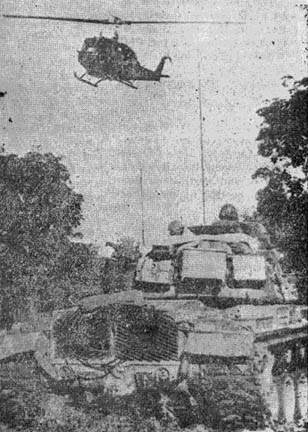 |
Brig. Gen. Flanagan New Assistant CO
Brig. Gen. Edward M. Flanagan Jr., formerly secretary to the general staff of
United States Army Europe Headquarters, has been assigned as the new assistant
division commander for the 25th Infantry “Tropic Lightning” Division.
Gen. Flanagan, 45, of Saugerties, N. Y., served in his last position for a
year at Heidelberg, Germany.
Gen. Flanagan, who holds the Legion of Merit, the Bronze Star Medal and the
Army Commendation Medal, is a 1943 graduate of the United States Military
Academy at West Point, where he received a bachelor of science degree. He was
also graduated from Boston University with a master of arts degree in Political
Science.
Gen. Flanagan. has also attended the Artillery Basic Officers’ course at Fort
Sill, Okla., the Armed Forces Staff College, the Army War College, the Air
Command and Staff School and the Command and General Staff College at Fort
Leavenworth, Kan.
The general’s past assignments include serving as commanding officer of the
674th Airborne Field Battalion in Korea and Japan, commanding officer of the 3rd
Armored Division Artillery, and intelligence officer for the Central Army Group.
| 1st MEDCAP in Phu Hoa Dong Medical Civic Action Programs (MEDCAP), an old good-will tactic in Vietnam, have found a new surge of popularity near the village of Phu Hoa Dong where the 25th is conducting its phase of Operation “Cedar Falls.” The war’s biggest ground effort sent infantrymen to an area approximately seven miles northeast of the division base camp. The first MEDCAP drew only 38 people. Capt. Leon Lando, a battalion surgeon, said that it was probably the first MEDCAP in the area. “Of the 9000 people living here,” he said, “about 4000 are Viet Cong. I think that the other 5000 are just a little afraid to trust us.” But after the first patients failed to die from American medicine as Viet Cong propaganda had promised, the popularity of the medics grew. The second MEDCAP treated more than 200 people and 300 more had appeared by the end of the third day. “One woman,” said a battalion medic, “wouldn’t let us give her baby a penicillin shot because of VC propaganda saying that we poisoned the children with our medicine. After she saw that the others didn’t die, she came back and let us treat him.” |
Col. Kingston, 1/35 CO, Awarded DSC
The Distinguished Service Cross, the Army’s second highest award for valor,
was presented to Lt. Col. Robert C. Kingston, commanding officer of the 1st Bn,.
35th Inf. “Cacti Green,” 3rd Brigade Task Force.
The presentation was made by Gen. Harold K. Johnson, Army Chief of Staff, at
a brief ceremony during his recent visit to Pleiku.
Col. Kingston was cited for valorous actions in Vietnam’s central highlands
while participating in Operation “Paul Revere IV.”
On November 22, two of the “Cacti Green” companies made contact with the
forward positions of an enemy North Vietnam Army (NVA) battalion. Col. Kingston
immediately landed by helicopter and assumed control of ground operations.
The lead company was pinned down by intense automatic weapons fire that
evening. Col. Kingston charged a wounded enemy soldier and wrestled a weapon
from him. And while firing the captured weapon he led an assault on the enemy
positions with such intensity that it forced them to flee.
Throughout the fierce, three-day battle, Col. Kingston exposed himself to
hostile fire, encouraged his troops and directed air artillery support.
|
Latest Reports |
| Operation | Province | FC | KIA | VCC | VCS |
| Lanikai | Long An | L | 75 | 12 | 97 |
| Ala Moana | Hau Nghia | L | 81 | 3 | 214 |
| Cedar Falls | Binh Duong | L | 399 | 69 | 400 |
Page 2 TROPIC LIGHTNING NEWS January 20, 1967
Pleiku Ceremonies
SS Awarded to Four
The Silver Star, the Army’s third highest award for valor, was awarded to
four men of the 3rd Brigade Task Force for heroic actions in recent operations against the enemy
in the Central Highlands of Vietnam.
The presentations were made by Gen. W. C. Westmoreland, commander of all U.S.
forces in Vietnam, and Maj. Gen. Arthur S. Collins, commander of the 4th Inf.,
,during recent ceremonies held in Pleiku.
The four awards went to 1st Lt. Marcel A. Guidry, 1st Bn, 14th Inf.; SSgt.
Gary M. Stickles, 1st Bn., 35th Inf.; PFC William F. Thornton, 2nd Bn., 35th Inf.,
and PFC William H. Sanderson, 2nd Bn., 35th Inf.
Lt. Guidry
Lt. Guidry was cited for heroism and courageous devotion to duty while under
intense enemy fire during a search and destroy mission in the central highlands
of Vietnam.
Immediately upon coming under fire, Lt. Guidry aggressively organized his
forces to maneuver against the well-entrenched enemy and set up a base of fire.
When the din became too loud to communicate with his squad leaders, he ran from
squad to squad through a hail of bullets to give orders.
Late in the battle, the company commander was seriously wounded. As soon as
he heard of this, the lieutenant took command of the company. He organized his
platoons to withdraw and evacuate all casualties. When radio communications
were lost, he braved oppressive fire to seek out the platoon leaders to give
them instructions.
While leading an evacuation party Lt. Guidry was wounded by grenade fragments
but refused to be evacuated. While wounded he led a maneuver force to destroy
an enemy sniper hampering the evacuation and positioned his men to secure an
adequate corridor for evacuation of other casualties.
Late that night after the fighting had ceased, Lt. Guidry organized the
company into a defensive perimeter and only then accepted medical treatment.
Sgt. Stickles
Sgt. Stickles was cited for his extraordinary heroism against a numerically
superior force of Viet Cong while serving as a squad leader during a search and
destroy mission near Trang Duc.
Moving toward their objective, the lead platoon received intense enemy fire.
In attempting to assist the beleaguered platoon, Sgt. Stickles’ unit was engaged
with a reinforced Viet Cong company and sustained several casualties. Aided by
two members of his squad Sgt. Stickles, on three separate occasions, moved
through the bullet-swept area to rescue a wounded comrade.
The wounded were then placed in a armored personnel carrier for evacuation
and during the course of the action the carrier was hit by a Viet Cong anti-tank
weapon and burst into flames. One man jumped from the vehicle afire with
burning gasoline. Sgt. Stickles ran to his colleague, tackled him and smothered
the flames. He then ran back to the burning vehicle, pulled out another wounded
man that was trapped inside and carried him to safety. Although wounded in the
process, Sgt. Stickles continued to lead his squad as they fought their way to a
landing zone where the wounded were evacuated.
PFC Thornton
PFC Thornton was cited for heroism while serving as a medic with the 1st Bn.,
35th Inf., during Operation “Paul Revere” in the Ia Drang River Valley.
When his unit was hit by intense hostile fire and sustained several
casualties, PFC Thornton was called forward to administer first aid to two
seriously wounded soldiers.
With complete disregard for his own safety, PFC Thornton crawled forward
while exposed to oppressive enemy fire and successfully administered medical
treatment to his stricken comrades.
On another occasion, PFC Thornton crawled within 15 feet of a fortified North
Vietnamese Army position and evacuated a wounded soldier.
Throughout the fierce battle, his courage saved the lives of many soldiers
and inspired his comrades to seize the initiative and rout the NVA force.
PFC Sanderson
PFC Sanderson was cited for heroism while serving as a medic with the 2/35th
Infantry during Operation “Paul Revere III.”
While moving toward its objective, PFC Sanderson’s platoon was hit by intense
hostile fire from a large fortified North Vietnamese Army force, and immediately
the left flank security suffered four casualties.
With complete disregard for his own safety, PFC Sanderson moved through the
bullet-swept area to render first aid fallen comrades. Finding the first three
mortally wounded, he pressed on to the fourth to administer aid. While treating
the wounded man, he was hit twice by sniper fire. Realizing he could not
adequately administer first aid from that position, PFC Sanderson dragged his
wounded comrade to a covered position and in the process was hit once again.
During the entire battle, PFC Sanderson, although in great pain, assisted the
wounded. Through his courageous efforts, he contributed immeasurably to the
unit’s success.
|
The Mail From Home |
 |
| RECEIVING - One of the more pleasant events to men in the field is mail call. Members of the 4.2-inch mortar platoon, 2nd Bn, 35th Inf, gather atop a bunker to receive news from home. (Photo by Sgt. Michael N. Horowitz) |
Lt. Col. Clinton Granger Assumes Command of 2/35th at Pleiku
Lt. Col. Clinton E. Granger Jr., of Champaign, Ill., assumed command of the
2nd Bn, 35th Inf., “Cacti Blue”, at a recent change of command ceremony.
He replaces Lt. Col. Philip R. Feir, who commanded the “Cacti Blue” for the
last eight months. Col. Feir departed to assume duties at the Office of
Personnel Operations in Washington, D. C..
Col. Granger was previously the brigade deputy commander.
In January of 1996 he first arrived in Vietnam and was assigned to II Field
Force, Vietnam, on the Secretary General’s Staff. In August, he became the
liaison officer and then went on to become the special assistant to the chief of
staff.
During the Korean War, Col. Granger served with the 279th Inf. as a platoon
leader and later became a company commander. He took part in the Korean
Summer-Fall 1952, the 3rd Korean Winter and the Korean Summer-Fall 1953
campaigns.
From Sept. 1953 through June 1956, Col. Granger was assigned to Fort Hood,
Texas, with a variety of duties. These ranged from being a company commander
with the 702nd Airborne Infantry Brigade to being assigned as liaison officer
with the chief of staff for the 1st Armored Division.
Col. Granger is a graduate of the U.S. Army Military Academy at West Point, he
has completed the basic and career courses at the Infantry School, Fort Benning,
Ga., and he graduated from the Command and General Staff College, Fort
Leavenworth, Kan., in 1962.
His decorations include the Combat Infantryman Badge with one star and Bronze
Star with Oak Leaf Cluster.
In his farewell speech, Col. Feir made the following comments:
“Today it’s my sad duty to relinquish command of such a great fighting
maneuver battalion.”
“To say that I do so with a great deal of reluctance would be the
understatement of the New Year.”
Following Col. Feir was the new Cacti Blue commander, who spoke briefly to
the assembled battalion.
Gen. Wier Visits Plei Sor Ngoi
When Lt. Kenneth Barton, 1st Bn, 35th Inf., civil affairs officer (S-5) made a
regular visit to Plei Sor Ngol, the battalion’s adopted Montagnard village, he
was surprised by Brig. Gen. James A. Wier,, U.S. Army, Vietnam, Surgeon General,
who arrived shortly after him.
Gen. Wier, who had been visiting the 18th Surgical Hospital, wanted to visit
the village to learn some of the customs of the Montagnard people. Lt. Barton,
who was there to give the villagers clothes and lard donated by the S-5,
explained to the general and his party some of the people’s customs and habits.
After a tour of the village the group was invited to participate in a
ceremony which made them blood brothers to the Montagnards. The event was
followed with a feast of chicken and rice wine.
The group was impressed with the way they were treated and attributed it to
the fact that the battalion has been working so closely with the village over
the past two months, bettering the living conditions of the villagers.
Accompanying Gen. Wier were members of the 44th Med Bde., headed by Col. Ray
L. Miller, brigade commander, and members from the 18th Surgical Hospital headed
by Lt. Col. Mark T. Genac, hospital commander.
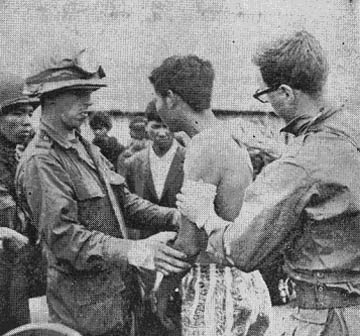 |
Treatment for Montagnards |
Page 3 TROPIC LIGHTNING NEWS January 20, 1967
Quick ARVN Saves 5 ‘Manchu’
By PFC Andy Jensen
Five American soldiers owe their lives to an Army of Vietnam (ARVN)
interpreter working with the division’s 4th Bn, 9th Inf “Manchu”.
Sgt. Duong Minh Phuoc killed a Viet Cong captive who tried to ignite a
grenade in an escape attempt.
The captive had taken an element of the battalion to a place where he knew
there were several mines, hoping his captors would set off a mine thereby giving
him the chance to escape. The unit hadn’t been in the area long when one of the
men triggered a mine wounding himself and several others.
The VC overpowered an ARVN soldier assigned to guard him, taking a grenade
from the ARVN’s belt. The VC was killed as he prepared to throw it at a group
standing nearby. His intended target was the battalion’s operations officer
(S-3), the company commander, three other American soldiers and Sgt. Phuoc.
As the captive raised his arm to throw the grenade, the ARVN sergeant fired,
hitting the enemy in the head. He then leaped forward and disarmed the
grenade. It happened so fast that it took everyone, including the interpreter,
several moments to realize what had happened.
After the encounter, Sgt. Phuoc was visibly shaken. With tears in his eyes
he looked at the man he had killed and quietly walked away.
When he returned to the “Manchu” base camp the interpreter was besieged with
the thanks of a grateful battalion for saving the lives of their comrades.
But the soft-spoken sergeant in his early twenties, remained silent, tears in
his eyes. To all questions and comments he replied, “I became an interpreter so
I wouldn’t have to kill but now I have.”
For his quick action, Sgt. Phuoc has been recommended for an American award -
of valor.
Perritt Is New Cmdr At 1/27th
Maj. Harvey H. Perritt Jr. recently assumed command of the 1st Bn, 27th Inf.,
“Wolfhounds” at Cu Chi.
Maj. Perritt, 38, of Alexandria Va., replaced Maj. Guy S. Meloy, who returned
to the United States for reassignment.
Maj. Perritt was graduated from the United States Military Academy at West
Point in 1952 with a bachelor of science degree.
A veteran of more than 20 years service the major entered the Army in 1916
after being graduated from John Marshall High School in Richmond. He was an
enlisted man for two years before entering the academy.
Maj. Perritt holds the Bronze Star Medal with first oak cluster, the Air
Medal and the Army Commendation Medal with first oak leaf cluster.
| SIGN WAR - A soldier displays a sign found nailed to a tree by the VC. The sign was found during Operation “Cedar Falls.” (Photo by PFC Vern Shibla) |
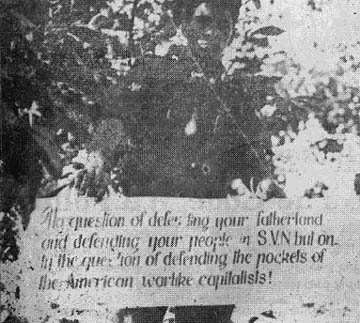 |
Said The Monkey to The Chimp
Aba-Daba-Daba-Daba-Daba-Daba-Daba
The mascot of the 25th Inf. Div.’s 4th Bn., 9th Inf. “Manchu” ammunition dump is
having a romance that is causing the battalion to lose shotgun shells.
The mascot of the section responsible for all the trouble is a baboon named
Fred. In October Fred assumed his place with the ammo men and took it upon
himself to become their protector. He sat on the sand bag wall surrounding the
ammo dump and allowed no stranger to pass. Even a first sergeant was once
halted by the watchful baboon.
But now Fred is not quite so watchful for he is in love. It was of little
interest until their supply of shotgun ammunition started to shrink.
A female monkey from a nearby cage had escaped and started a romance with
him. The problem began when Fred’s girlfriend started bringing him gifts of
love from the ammo pile.
By the light of the moon two lovers meet and chew up shotgun shells that she
brings to the nightly feast. The “Manchu” have tried to break up this little
romance but have had almost no success.
Love conquers all or at least it has for the moment for Fred and his lover
are still dining each evening on shotgun shells from the “Manchu” ammo dump.
| Bring Out the Skis; Mercury Dips to 65 When the normally hot and humid night-time temperatures at Cu Chi dipped to a low of 65 degrees on Friday the 13th, men of the 25th Inf Div were not surprised. After all, the day is traditionally famous for throwing quirks into normal habits. So when the infantrymen found themselves shivering under winter wool blankets, they resigned themselves to the fact that Friday the 13th does things like that. However, one serviceman at the base camp took advantage of the day to stage a one-man crusade against superstition. “Ridiculous,” piped Air Force Technical Sergeant Vincent R. Casella, chief observer at the Lightning Weather Station. “The whole thing can be explained scientifically,” said Sgt. Casella as he stepped up to a detailed map and pointed out how cold air from Siberia is pushed across the South China Sea and into Vietnam during China’s Northeast Monsoon Season. “As the air crosses the sea,” he explained, “it is warmed from well below zero temperatures to the seventy-or-so degrees it usually reaches by the time it arrives in Cu Chi.” “The longer the air stays in Siberia, the colder and less humid it gets,” Sgt Casella said. “We just got a whiff of air on the 13th that stuck around in Siberia longer than usual.” The lowest temperature previously recorded was 68 degrees last December 30. The average night-time temperature for January in Vietnam is 70 degrees. “That’s all there is to it,” the Weatherman concluded. “Just a coincidence that the cold air showed up on the day everyone associates with bad luck and discomfort.” |
Southern Hospitality
Blakely, Ga., Helps Bac Ha, VN
By Sp4 Dan Desmond
The small town of Blakely, Ga., recently helped the 25th’s Revolutionary
Development Program by donating over $200 and 11 large boxes of clothing to the
village of Bac Ha, located just outside the Cu Chi base camp.
Bac Ha was founded in the early 1950’s when almost 13,000 refugees from the
Hanoi area drifted south and settled in Hau Nghia Province. Their main source
of income was the production of fire works but in 1960 the Vietnamese government
outlawed the explosives. With no way to provide for their families, most of the
village men decided to move into the metropolitan areas and soon Bac Ha’s
population was cut in half. Viet Cong terrorist activities in recent years
again dropped the hamlet’s population to 700 people.
When the division arrived in Vietnam last January, it set up its base camp
just a few hundred yards from the village. The close distance between the
village and base camp also brought close relations between the two and soon the
division’s Support Command began aiding Bac Ha and its Catholic parish.
A few months ago, Capt. Herbert R. Maddox, the intelligence officer (S-2) of
Support Command, wrote his wife Evon, telling her of the conditions in the
village. Feeling compassion for the people, Mrs. Maddox asked Mayor Hugh
Redding of Blakely to conduct a drive in order to help a family living in Bac
Ha.
Through Mayor Redding’s efforts, the local radio station and newspaper
publicized the drive and the whole town opened their hearts. Mrs. Maddox
personally made house calls to keep donations at a maximum. When the month-long
drive ended Mayor Redding turned the collected items over to Mrs. Maddox. She
packed them up in boxes and sent them to her husband at Cu Chi. A separate
envelope contained the money which was exchanged for 23,600 piasters. When
Capt. Maddox received the items he decided to distribute them among three
families. “I thought that such a large sum of money and clothing was too much
for one family and would cause jealousy in the village,” he said. “So I selected
the three neediest families and distributed the items among them. All were
families who lost their husbands and fathers in the war, two of them through
Viet Cong terrorist actions.”
Now Capt. Maddox has made three families happy and brought the division a
little closer to its Revolutionary Development goal.
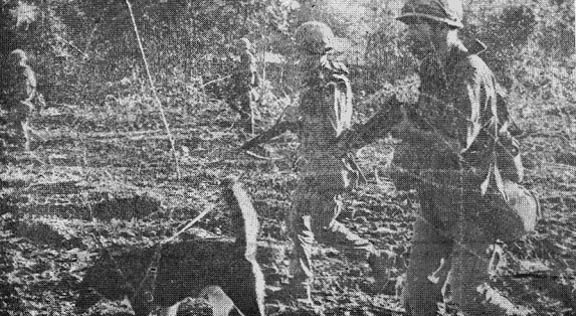 |
|
Scout dogs and division troops search in “Cedar Falls.” (Photo by PFC Vern Shibla) |
Page 4 TROPIC LIGHTNING NEWS January 20, 1967
Decorated
| SILVER STAR MEDAL (POSTHUMOUSLY) | |
| PFC David Gregory, Co B, 2nd Bn, 1st Inf. | |
| BRONZE STAR MEDAL (VALOR) |
|
|
1st Lt. Thomas P. Byrne, Trp B, 3rd Sqdn, 4th Cav. Sgt. Eugene Mosher, Co B, 1st Bn, 5th Inf. Cpl. Ronald Mayberry, Btry A, 3rd Bn, 13th Arty. Sp4 Robert Furguson, Co B, 1st Bn, 27th Inf. |
Sp4 James T, Padgett, Co C, 1st Bn, 27th Inf. Sp4 Robert Smith, Co C, 1st Bn, 5th Inf. Sp4 Thomas F, Tome, Co C, 1st Bn, 27th Inf. PFC James N. Wymer, Trp A, 3rd Sqdn, 4th Cav. (Posthumously) |
| ARMY COMMENDATION MEDAL (VALOR) |
|
|
1st Lt. Lynn Alexander, Btry A, 3rd Bn, 13th Arty. 1st Lt. Edward P. Brinkman, Btry A, 1st Bn, 8th Arty. 1st Lt. Edward Corcoran, Btry A, 3rd Bn, 13th Arty. SFC Raymond Lindner, Btry A, 1st Bn, 8th Arty. |
SFC Leonard Varnadore, Btry A, 3rd Bn, 13th Arty. SSgt. James Gillett, Btry A, 1st Bn, 8th Arty. Sgt. Robert D. Ward, Btry A, 1st Bn, 8th Arty. Sp4 Leon H. Monty, HH&S, 3rd Bn, 13th Arty. |
| AIR MEDAL (VALOR) |
|
|
Maj. Glenn T. Feilke, Co A, 25th Avn Bn. Capt. Leon B. Cloud, HH&S, 1st Bn., 8th Arty. Capt. Valmore Girard, HH&S, 1st Bn., 8th Arty. |
Capt. Gary Hatfield, Trp D, 3rd Sqdn, 4th Cav. 1st Lt. Max Johnson, H&S, 7th Bn, 11th Arty. 1st Lt. Joel M. Price, Co B, 25th Avn Bn. |
| BRONZE STAR MEDAL |
|
|
SFC Hoyt C. Nelson, HHC, 1st Bde. SSgt. Billie Goins, HH&S, 1st Bn, 8th Arty. SSgt.. Roland Lamontagne, HHC, 1st Bn, 5th Inf. SSgt. Richard Massie, Co A, 1st Bn, 27th Inf. SSgt. Henry McClenton, Co A, 1st Bn, 27th inf. |
SSgt. William Mitchell, 25th Admin Co. SSgt. Eugene Tucker, HHC, 1st Bn, 27th Inf. Sgt. George Eaton, HHC, 4th Bn, 23rd Inf. Sgt. James Vaughn, Co C, 1st Bn, 5th Inf. |
| PURPLE HEART |
|
| SSgt. James K. Lindsey, Co A, 1st Bn, 5th Inf. | PFC Ronald Huzinec, Co A, 1st Bn, 5th Inf. |
Roots of Vietnamese Buddhism Trace Back to India – 500 B.C.
(Editor’s Note: This is the second in a series of articles describing the
major religions of Vietnam and their relative influence upon its people and
their history.)
The early concepts and doctrines of the religion known as Buddhism were
written in the sixth century B.C. by a man called Gautama, also known as the
Gautama Buddha. He was to Buddhism what Christ was to Christianity. He taught
his people about the futility of all earthly endeavors and showed that the only
way of achieving a state of “nirvana “ (the Buddhists conception of heaven), or a perfect union with the Mystical One that
presides, is that each person must suffer the miseries of life through a series
of incarnations.
Buddhism over the centuries became one of the major religions of Asia. The
two branches of Buddhism are MAHAYANA, the Greater Vehicle, and HINAYANA, the
Lesser Vehicle. MAHAYANA Buddhism, the form which was popular in China, has
also achieved popularity in V. N. The HINAYANA Buddhism of neighboring Cambodia
and Laos has some following in Vietnam and has influenced some of the new lesser
sects.
The distinction between the two types of Buddhism rests on their respective
view of the Gautama Buddha. The Hinayanists regard him as the one Budha and a
great teacher, although not endowed with divine powers. The Mahayanists, on the
other hand, teach that although he was divine he was not the only ruling being
in the universe.
Theoretically any person may become a Buddhist, but those who actually attain
Buddhahood (Buddhism’s equivalent of sainthood), are very rare. Saints, or
persons who earnestly try to attain the perfection of Buddha are known as
“bodhisattvas,” an array of superhuman beings. Buddhas and bodhisattvas are
thus recognized and venerated in Mahayana temples.
Few Vietnamese are acquainted with or care much about Buddhism’s elaborate
structure and the values it teaches. What appeals to them is Mahayana ritual
and colorful imagery, although these play a limited role in Vietnamese religious
life.
The Mahayana Buddhist temples are loosely related in regional and national
associations. The priests who maintain them, although they recite the
appropriate prayers, are rarely learned in the sacred literature of Buddhism.
On the occasion of a funeral or the celebration of a wedding, birth or
anniversary, the Buddhist priest may be called in to offer prayers. His
services may also be enrolled on special occasions as a spirit mediator between
those living and those who have passed away. The Buddhist priest is also in
demand to lead the community in solemn ceremonies, commemorative feasts and in
tines of trouble. The Chinese in Vietnam have their own Buddhist and priests
and Mahayana temples.
Next Week: Confucianism.
Editorial
The Code We Follow
Although a formalized Code of Conduct dates from 1955, the ideas it expresses
have guided American fighting men all through our country’s history. The Code
simply puts these old and honored ideas into specific form.
 While standing at the gallows to die after being captured by the British in
1776, 21-year-old Capt. Nathan Hale of the Continental Army said: “I only regret
that I have but one life to lose for my country.”
While standing at the gallows to die after being captured by the British in
1776, 21-year-old Capt. Nathan Hale of the Continental Army said: “I only regret
that I have but one life to lose for my country.”
While leading his company in France during World War I, 1st Lt. Samuel
Woodfill rushed ahead of his line three times in the face of fire to kill and
capture the enemy with his pistol, a pick and his bare hands.
In a heroic deed that involved no war, 20 volunteers joined Maj. Walter Reed
and three other medical officers in risking their lives by exposing themselves
to tropical mosquitoes which carried malaria. Fifteen of the men contracted
yellow fever and two of them died in the mission which resulted in Maj. Reed’s
discovery of the carriers of malaria.
These are but three of the many examples of heroism described in the history
of the American fighting man.
Not every member of the Army is assigned to a combat unit. Not every member
of a combat unit has the primary duty of closing with the enemy. Nevertheless,
every soldier, whatever his unit or his primary duty, can truthfully say, “l am
an American Fighting Man.”
 |
| The TROPIC LIGHTNING NEWS is an
authorized publication of the 25th Infantry Division. It is published
weekly for all division units in the Republic of Vietnam by the
Information Office, 25th Infantry Division, APO U.S. Forces 96225. Army
News Features, Army Photo Features, Armed Forces Press Service and Armed
Forces News Bureau material
are used. Views and opinions expressed are not necessarily those of the
Department of the Army. Printed in Saigon, Vietnam, by The Vietnam
Guardian. Maj. Gen. Fred C. Weyand . . . . Commanding General Maj. William C. Shepard . . . . . . Information Officer 1st Lt. William H. Seely III . . . . Officer-in-Charge Sp4 David L. Kleinberg . . . . . . . Editor Sp4 Adrian E. Wecer . . . . . . . . Editorial Assistant |
Page 5 TROPIC LIGHTNING NEWS January 20, 1967
No Comprende?
Sp4 Raul Vega Translates at Division Finance
Members of the finance section, 25th Admin Co, at Cu Chi, are glad to have
Sp4 Raul Vega around. Several times a week the Long Island, N. Y., soldier is
called upon to act as a translator for his fellow workers.
Often, replacements who speak little or no English report to the section for
processing. In most cases, the only language spoken is Spanish. That’s where
Specialist Vega comes in. Born in Puerto Rico, the 21-year-old soldier speaks
fluent English as well as his native Spanish.
The processing section handles all personnel joining or leaving the division.
When a man arrives at Cu Chi, after taking a leave between his last duty
station and reporting to the 25th, he must fill out a travel voucher, a job
handled by Sp4 Robert Dunworth, 22, of Sayerville, N. J.
Specialist Dunworth relates that on one occasion, a man came in for
processing and was asked if he took leave before coming to Vietnam.
The reply, “Yea!”
“Did you receive travel pay before leaving your last assignment?”
“Yea!”
“How many days leave did you take?”
“Yea,” was the reply for the third time.
“By now I realized he didn’t speak or understand English so I called
Specialist Vega,” explained Specialist Dunworth. “He straightened things out in
about five minutes. As it turned out, the soldier didn’t receive travel pay
after all. Things like this happen two or three times a week and when we’re
busy, like we have been for the past few months, we must work as fast as
possible. We’d never make it without Specialist Raul,” he ended.
When asked how he likes his double-duty, Specialist Vega said he enjoys the
change of pace and sometimes finds it amusing. “Once,” he said, “I talked to a
fellow and after filling out his travel voucher he said to me, ‘Man it’s good
thing you’re around or I’d spend my whole day trying to process’.”
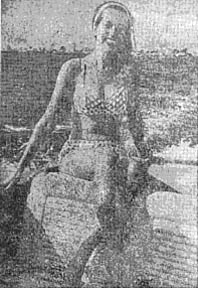 |
OKAY, INVITING - Pretty Bonnie Landrum invites one and all to come for a ride with her along Florida’s shoreline. Scene is Florida’s gulf coast, and the water looks inviting. |
3/21 ‘Gimlet’ Medics Find A Promise in MEDCAPs
When the “Gimlet” medics of the 3rd Bn, 21st Inf., 196th Lt Inf. Bde., were on
their 30-day voyage to Vietnam, they had all sorts of visions of what they would
be doing for a year in the combat zone.
Their dreams, or perhaps nightmares, were filled with visions of men being
rushed into the battalion aid station with gaping wounds. For the line medic
who spends his days in the field on operations, these nightmares have been all
too true. For the medic assigned to the aid station, the situation is
different.
The aid station medic has found a different type of activity, with new
maladies to care for. The activity is the MEDCAP (Medical Civic Action
Program), and the maladies are the ills that plague the local Vietnamese
populace.
About three times a week, the “Gimlet” medics, under the supervision of the
battalion surgeon, Capt. Richard J. Rose, grab their medical supplies, hop in
the jeep, and take off for a hamlet. There is no doubt in the villager’s minds
why the jeep with the big red cross on its side is there.
There is much joy and satisfaction to be gained from this type of work. The
medic knows that he is doing a humanitarian thing.
There are heartbreaks too, however. More than once there has been the cute
little girl stricken with polio as a baby who is now paralyzed from the waist
down. In the United States there would be hope. The child would get braces or
physical therapy. Unfortunately in Vietnam little can be done.
The “Gimlet” medic has leaned to face this reality and perhaps has found a
new dream.
|
WHOOPS! |
 |
|
By Pvt. McLightning
|
 |
DANCE, EVERYONE, DANCE - School children dance in honor of the 25th soldiers who have just given a party for the 611 children of Tan Hoa, located 20 miles west of Saigon. The party included cake, punch and presents for each child. It was sponsored by the 7th Bn, 11th Arty. (Photo by Sp5 Todd Darch) |
Page 6-7 TROPIC LIGHTNING NEWS January 20, 1967
CHANGE OF THE GUARD – 175s GET NEW TUBES
30 Men, 3 Cranes, 3 Hours Required
Because of the tremendous internal pressure needed to send 175mm
shells over long distances, the life span of the tube on a 175mm self-propelled
gun is relatively short. The short life span necessitates changing the
tubes whenever they wear out.
The changing of the $18,000, six-ton tubes takes 30 men, three
heavy cranes and three hours of work. The tubes are sent to research labs
at Aberdeen Proving Grounds, Md., where they are tested with a view toward
lengthening the life span of the tube.
When the tests are completed, they are sent to the manufacturer who
melts the old tube and casts a new one.
To ressupply the big guns of the 2nd Bn, 32nd Arty, at Cu Chi, the
division’s 725th Maint. Bn. takes its trucks to Long Binh, some 20 miles away.
Two tubes can be carried on each of the battalion’s “low boy” trucks.
The removal and replacement of a new tube requires incredible
coordination between the gun driver and the operators of the two cranes holding
the tube. The tube must be held at the pre-set angle determined by the
grooves on the frame of the gun itself. As the tube moves forward in these
grooves, the entire tube must be raised, because the angle is slightly above the
horizontal. Both cranes, independently operated, must raise the same
amount at the same time to keep the tube at the same angle.
| Photos by SP4 James Pardue |
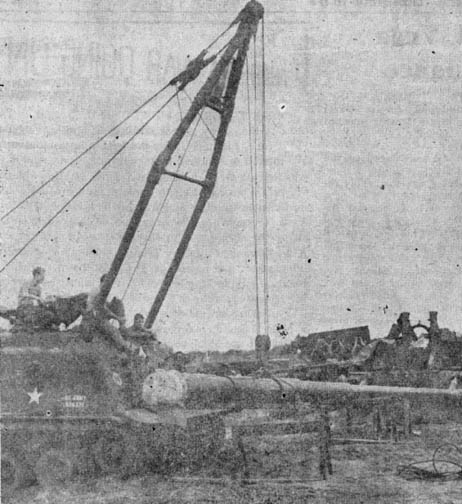 |
Tracked vehicle from 725th hoists old gun tube away |
| 725th strains to thread on the new tube |
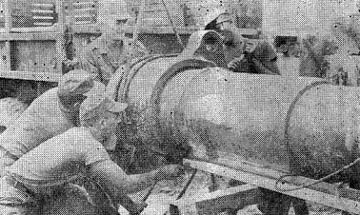 |
 |
Maintenance men grease the threads for the breech ring |
| Backing up to meet the new tube |
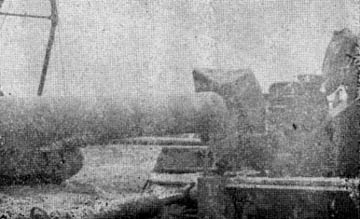 |
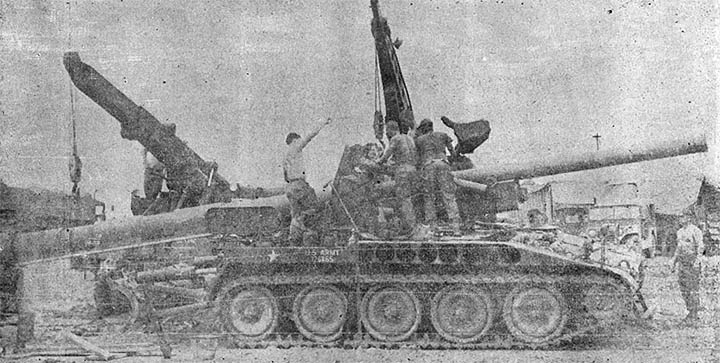 |
|
Men of 2/32nd and 725th work as the big tube slowly slips into position. |
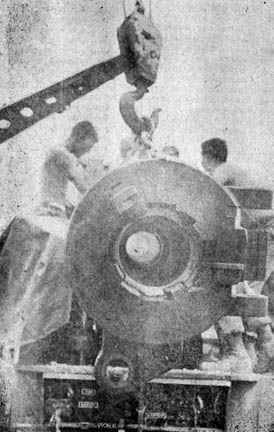 |
New tube almost in position |
| Finished product, ready to get Charlie |
 |
Page 8 TROPIC LIGHTNING NEWS January 20, 1967
|
|||
| OMNIPRESENT - Whether in the field or in a hamlet, the 3rd Spdn, 4th Cav, is always on the alert and ready to lend a watchful weapon or helping hand. Left, a crew of an M-48A1 tank keeps a constant watch on Highway 1 as part of road security. In the “new life hamlet” of Tan Thoi workers paint shutters of their new school, a direct result of self-improvement program initiated and supplied by the Cav. Right, a mother in Tan Thoi buttons a new sweater for her small child during a 25th division MEDCAP. The clothes were also supplied by the Cav. (Photos by Sp5 Todd Darch) |
Superstition: 25th Div Pulls Ace on Viet Cong
To those who believe in them, taboos, omens and superstitions are just as
real as the wind and rain. Looking closely at some of the more popular
Vietnamese customs, traits and superstitions offers an interesting insight into
the life of the people.
With the 25th Infantry Division, one thing that has been uncovered and used
successfully against the Viet Cong is the ace of spades. Positioning of one of
these cards along a route is supposed to mean bad luck and the place is avoided
by the VC.
In eating, one unusual facet of the Vietnamese host is the offering of choice
portions of the main dish to a guest. With an American as a guest this usually
works fine except if the main dish is chicken. To honor the guest, the choicest
part of the bird is brought forth and served - the head.
In Vietnam, mirrors are often placed on front doors so that if a dragon tries
to get in the house, he will see his reflection and thinking the house already
has dragon and will go away.
Few U.S. personnel realize that it isn’t considered polite to touch anyone on
the head. Many Vietnamese believe the spirit resides there. Also never touch
anyone on the shoulder for many believe a genie rests there.
Vietnamese people have a habit of not looking a person in the eyes because of
shyness: rank is greatly observed in the home as well as the office, and a baby
is considered to be a year old at birth.
The Vietnamese believe that a person should die at home and in bed. It is
considered bad fortune to die away from home and bad luck to be carried home
dead.
A great many Vietnamese people sleep with a lamp lit next to the bed to keep
evil spirits from getting their soul while asleep.
Most Vietnamese’ names are backwards to Americans. They consist of a family
name, middle name and a personal or given name, which would make Al K. Haul
called Mr. Al in Vietnamese, instead of Mr. Haul.
All these facts are not commonly known but could be important in everyday
dealings with the Vietnamese. Reading more about the country in which you are
now fighting will prove both interesting and enlightening.
1st Sergeant Likes 25th ‘Second Time Around’
The song says “love is better, the second time around.” For 1st Sgt. Thomas
C. Merideth, Co B, 25th Avn Bn, the song lyrics seem to also apply to war.
Sgt. Merideth served with the 25th Inf. Div. during the Korean War and is
currently in Vietnam with the same Division. Sgt Merideth is authorized to wear
the patch of the “Tropic Lightning” Division on both shoulders.
Born in Philadelphia, Miss., Sgt. Merideth began his military career with a
year tour in the Air Force. In 1949 he decided to try Army life and was
assigned to Co A, 35th Regt, 25th Inf Div at Ousu, Japan. He remained with this
unit for three years during the Korean Conflict, was promoted to sergeant first
class and made platoon leader of the 4th platoon of his company.
Early in 1952 Sgt. Merideth recognized the potential of Army Aviation and
began a career in this field. In August of that year, he moved with the
Aviation School from Fort Sill, Okla., to Fort Rucker, Ala. He has watched Army
Aviation grow and mature from the days of the L17/s and H-25s to the Mohawks and
Huey helicopters of today’s modern Army.
After ten years with the Army Aviation School and various aviation units,
Sgt. Merideth was transferred back to the outfit with which he started his Army
career, the 25th Inf Div at Schofield Barracks, Hawaii. Since May 1963 Sgt.
Merideth has served with the 25th Avn. Bn and is currently the first sergeant of
Co B which provides general air support for the “Tropic Lightning” Division.
To date Sgt. Merideth’s decorations include the Combat Infantryman Badge, the
Bronze Star, Air Medal with cluster, Purple Heart and Senior Crew Members Wings.
 |
|
1st Sgt. Thomas Merideth |
MEDCAP by 3/21st Inf
Marking their 30th MEDCAP in three months, Dr. (Capt.) Richard J. Rose and
five medical aid men of the 3rd Bn, 21st Inf. recently treated 98 persons of the
Cao Xa village in Tay Ninh Province.
Six children with eye problems were brought to Dr. Dose’s attention. The
children will be sent to an ophthalmologist at the 3rd Field Hospital in Saigon.
The MEDCAP was made in conjunction with an immunization program started in
the village three weeks ago. The program is a four-part process aimed at curing
typhoid and para-typhoid fever. The first immunization shots were administered
to 385 persons.
175mm Cannons: Still Shake Up 196th Camp
When Btry C, 2nd Bn, 32nd Arty, moved into the base camp of the 196th on
September 19, few people were immediately aware of the big 175mm guns. But when
the first of those 147-pound high explosive projectiles blasted off into the
night people took notice.
Formerly comprised of four 175mm self-propelled guns, Btry C now boasts two
175’s and two 8-inch self-propelled howitzers, which have the largest bore
diameter of any of the Army’s conventional cannons.
Commanded by Capt. Bernd Pasler of Toledo, Ohio, Btry C provides general
heavy artillery support and reinforcement for the 196th brigade’s infantry units
anywhere within more than 20 miles of the base camp. Since arriving in Vietnam
in October 1965, more than 15,000 rounds have been fired by the battery.
Not the least of Btry C’s jobs is the training of replacements for departing
members of the 13-man gun crews. Section chiefs, who are staff sergeants, all
have considerable experience on the big guns.
Frequently the newer members of the crews have never before worked with
anything larger than a 105mm howitzer. The new personnel learn rapidly under
the pressure of combat fire missions, however, and the crew’s efficiency does
not suffer.
 |
Lt. Col. Walworth F. Williams receives the battalion colors of the 4th Bn (Mech), 23rd Inf., from Maj. Gene A. Mitchell, acting battalion commander, during a recent change of command ceremony, at Cu Chi. (Photo by Sp4 Rich Calvo) |
Page 9 TROPIC LIGHTNING NEWS January 20, 1967
TROPIC FLASHES
![]()
196th Lt Inf Bde
Brig. Gen. R. Knowles, CO
Capt. M. Randall, IO
“Chargers”
After having completed 25 missions over hostile territory, two artillery
lieutenants of the 196th Lt Bde have been awarded the Air Crewman Wings.
Receiving the awards were 1st Lt. Richard H. Jackson of Newport, Me., and 2nd
Lt. Michael Moseley of Moorestown, N.J. Both officers are the first members of
the 3rd Bn, 82nd Arty.
The lieutenants flew as forward artillery observers for the “Flying Red
Horsemen,” completing most of their missions during Operation Attleboro.
2nd Lt. Adrian J. Sipple became the first man in the 196th to receive a
direct commission while serving in Vietnam. 196th commander, Brig. Gen. Richard
T. Knowles, recently pinned the gold bars on the former WO helicopter pilot.
Capt. Michael T. Raune of Jersey City, N.J., assumed command of Co C, 4th Bn,
31st Inf, from outgoing Capt. Alfonso Izzi in a recent ceremony at company
headquarters. Before assuming command of the “Polar Bear” company Capt. Raune
served as S-3 (Air) with HHC, 3rd Bn, 21st Inf.
Capt. Raune’s first official business as new company commander was to swear
in four enlisted men who reenlisted for a combined total of 17 years.
Capt. Izzi has assumed duties as assistant brigade S-4.
Co A, 3rd Bn, 21st Inf, opened the doors of its new’ enlisted men’s club
recently. Capt. Emil Gregg of Hazelton, Pa., Co A’s commanding officer,
officially cut the ribbon.
A four-speaker stereo system provided the sounds as the men forgot the war
for a while around the tables or relaxed on the sofas and lounge chairs in the
TV room.
Meanwhile, Troop F, 17th Cav, opened the doors of its elaborate new NCO club
recently. The grand opening featured free steaks and beer, with music provided
by a six-piece band from the Philippine Civic Action Group.
The new club features a 26 foot mahogany bar, while a red brick veneer adds a
touch of class to the outside. Troop F cavalrymen especially enjoy the club’s
patio with its swaying palms.
How well is the new club doing? SSgt. Elmer Quist of Colorado Springs,
Colo., says, “I wish I had a business like this back in the States.”
![]()
125th Sig Bn
Lt. Col. T.J. Ferguson, CO
Capt. Dan Demchuk, IO
Joining the ranks of the 125th Sig Bn early this month was Maj. Harold E.
Hutchinson who came to the “Tropic Lightning” division after graduating from the
Command and General Staff College. Maj. Hutchinson is no novice in the field of
tactical communications having served as division Radio officer and assistant
Division Signal officer with the 8th Inf. Div. in Germany. From July 1964 until
August 1966 he served as a Project Officer in the Communication Electronic
Agency of the Combat Development Command, Fort Hauchuca, Ariz., where he was
principally concerned with tactical communication studies. Maj. Hutchinson has
been awarded the Army Commendation Medal with two Oak Leaf Clusters.
His new assignment with the 25th Division is that of Assistant Division
Signal Officer.
12th Evac Hosp
Lt. Col. Joseph L. Hannon, CO
Maj. Joe Gipson, IO
Promotions were given recently to 2nd Lt. Head to 1st Lt., PFC’s Mackey C.
Horning, Nortunen R. Meuller, Toy A. Mackey and E. Rose to Sp4, and PVT’s Reed
and Tucker to PFC. Pictures were taken and congratulations given.
Capt. David Gaw, a member of the medical staff, and Mrs. Gaw are the proud
parents of a new baby girl. Their daughter was born on Jan 5th, weighing 8
pounds, 6 1/2 ounces. The message received said that both mother and child are
doing fine.
Sp4 Michael W. Hoyt was named “Soldier of the Month” for January. Answering
questions in a superior fashion and looking his best was the winning
combination. He earns the right to compete in the Soldier of the Month board at
the 68th Medical Group in the future.
A USARV message recently directed that hospitals commence awarding Purple
Hearts to patients wounded as a result of hostile action. It will be the
repsonsibility of the 12th to present Purple Hearts to all persons who remain
over 24 hours with the hospital. Persons leaving the hospital in less than 24
hours will be presented the award at the next hospital, while the survivors of
those killed in action will receive the medal from Department of the Army.
2nd Brigade
Col. Marvin Fuller, CO
Lt. Albert Karel, IO
HHC
Headquarters welcomes new brigade chaplain, Maj. Thomas J. McInnes and HHC
1st Sgt. Vicente Remediz. Sgt. Remediz arrived in Vietnam from Ft. Bliss, Tex.,
after serving with a recruit training unit.
![]()
1st Bn, 27th Inf
”Wolfhounds”
A new “ultra-modern” fire direction center is under construction in the 1/27
area under the direction of 4.2 platoon leader Lt. Carter Ashcraft.
Capt. Roger L. Taylor takes the place of Capt. Jerry Turner as battalion
commo officer. Capt. Turner has rotated back to the states.
![]()
2nd Bn, 27th Inf
”Wolfhounds”
Lt. Calvin Neptune joins the 2/27 from Ft. Sam Houston, Tex. He will serve
as a medical platoon leader.
![]()
1st Bn (Mech), 5th Inf
“Bobcats”
The officers and men of the Bobcats said goodbye to Lt. Col. Victor Diaz and
welcomed new “Bobcat 6” Lt. Col. Richard C. Rogers.
![]()
2nd Bn, 14th Inf
Lt. Col. Charles Gillis, CO
Capt. D. Moore, IO
“Battle Dragons”
Promotions were making news at the 2/14th, too. Gary G. Friend, the
battalion liaison officer, was promoted to captain. Others gaining the rank of
captain were John P. Otjen, Co A commander, Richard L. Gray, formerly executive
officer of HHC, and Gary A. Cecchine, assistant S-3.
Twelve men were promoted to sergeant. They are Melvin J. Brown, Michael A.
Clifford, Steven F. Pittle, Michael Fredrickson, John W. Mullins, Arthur F. Rasmus,
James B. Steel, Thomas D. Danowski, all of HHC; and Johnnie Wylie, Larry Gainey,
Lee Scott and Darrel Colwell of Co A. Making Sp5 were James Parlor, James I.
Crabtree, Donald R. Absher and Shaversh Keulian, all of HHC.
Capt. Daniel J. Deliz, former battalion S-2, was reassigned as Co C
commander. 1st Lt. Charles E. DeWese has been reassigned to Co C as executive
officer.
Bunker Has 8 – And More
Medics of the 2nd Bn, 14th Inf., under the supervision of SSgt. Robert Brown,
completed a solid eight-man bunker in one day recently at Rach Kien.
It was supposed to be for eight men. That night, only hours after its
completion, Viet Cong mortars hit the base camp and when Sgt. Brown made a count
of his medics he found the bunker could hold a few more than eight.
| Cu Chi Charlie . . . By PFC John Fekete |
 |
Page 10 TROPIC LIGHTNING NEWS January 20, 1967
Inter-Platoon Rivalry Ends as 17th Cav Unit Rescues Mates
Inter-platoon rivalry is an old Army tradition often stimulating better
morale and increased efficiency. Recently Troop F, 17th Cavalry, 196th Brigade,
was involved in an action in which rivalry was all but forgotten.
Troop F’s third platoon was on patrol not far from the 196th Lt Inf. Bde. base
camp at Tay Ninh. Dusk was setting in as the eleven-man patrol separated with
five men going to the right and six going left looking for hidden Viet Cong
supplies.
Suddenly VC fire poured in from three sides pinning down both elements of the
patrol.
PFC Anthony Sperlazza of Howard Beach, N.Y., remembers firing his M-79
grenade launcher, hitting a VC in a tree and watching him plummet to the ground.
At the Troop F command post an urgent message was received from the pinned
down patrol. Sgt. David M. Morris was monitoring the radio.
“I ran to the second platoon area and told them that the patrol from the
third platoon was pinned down under heavy fire,” he said.
Sp4 James R. McCardell of Warwick, R.I., remembers: “We were playing cards in
the tent when word came that part of the third platoon was pinned down. We
grabbed weapons and web gear and headed for our jeeps. Men were putting on
shirts and lacing boots as we went out the gate.”
“When we heard our men were pinned down it was the fastest we ever moved out
of the area,” recalls Sp4 Joseph Rodriguez of Manhattan, N.Y.
In less than four minutes the second platoon relief force was on the scene
under the direction of Troop F commander Capt. Clyde W. Roan of Daytona Beach,
Florida.
One element of the pinned down third platoon patrol was then able to link up
with the second platoon which was now laying down a heavy base of fire.
The second platoon’s firepower enabled the rest of the patrol to move to
safety. By this time it was completely dark, and the Viet Cong slipped away
into the thick jungle.
The men of the third platoon patrol only speak in superlatives of their
rescuers, the second platoon, as all feelings of platoon rivalry were set aside.
“Thank heavens for the second platoon,” beamed PFC Sperlazza.
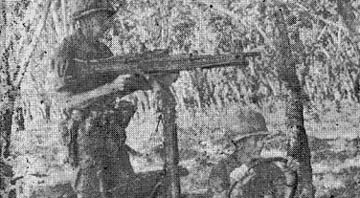 |
CLEAR THE ROAD - Men of Troop F, 17th Cav, observe a suspected VC site in a rubber plantation south of Tay Ninh. The Cav is on a road clearing mission. (Photo by PFC Chris Perales) |
Oh Where, Oh Where, Have the Viet Cong Gone
Co A, and Bn, 21st Inf, 196th, will go a long way to find VC who are willing
to fight, but some days you just can’t raise a thing.
“Action Alpha” had set up a command post just off the road over a mile from
the base of Nui Ba Den mountain. The company commanded by Capt. Emil Gregg of
Hazelton, Pa., moved out later to sweep and clear the area parallel to the road
opposite Nui Ba Den.
After progressing a mile through alternating areas of plowed fields, dry rice
paddies and jungle, the company crossed the road at its far end and faced the
small hump of the mountain, known as Nui Cao.
At this point the artillery forward observer, Lt. Michael Moseley of
Moorestown, N.J, called a recon-by-fire mission on Nui Cao, but the exploding
rounds drew no response. Capt. Gregg then moved the company into a relatively
clear patch of elephant grass about 200 yards from the base of the mountain,
where the lead squad put a two-minute burst of M-16, machinegun and grenade
launcher fire into the side of Nui Cao. Still no response.
The company, in a vain effort to draw even a little sniper fire, began the
long trek back to their CP, walking within 50-100 yards of the base of the
mountain. But Charlie was not to be drawn out of wherever he was hiding, and
the eight-mile sweep was completed early in the afternoon with no contact having
been made.
| DAWN PATROL - Infantrymen of the 196th Lt Inf Bde, slog through an ankle-deep stream in search of the VC south of the bde’s base camp at Tay Ninh. (Photo by PFC Chris Perales) |
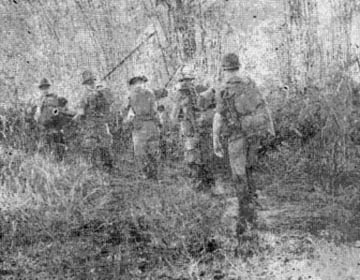 |
2nd Bn, Ist Inf, Captain Weins Silver Star
The nation’s third highest award for gallantry in action, the Silver Slar,
has been awarded to Capt. James P. Thompson, Co C commander, 2nd Bn, 1st Inf,
196th Lt Inf Bde.
While on Operation Attleboro, Co C of the “Guardians” battalion was placed
under the operational control of the 1st Bn, 27th Inf.
Late in the afternoon Co C of the 2nd Bn, 27th Inf, was cut off by enemy
forces as it attempted to link-up with elements of the 1/27th.
Darkness had fallen and the company had sustained light casualties. Water
and ammunition were short.
Capt. Thompson was ordered to move his company to the relief of the
beleaguered unit and effect a linkup.
Capt. Thompson immediately assembled his company and moved forward through
dense jungle toward the cutoff unit in complete darkness.
About 40 yards beyond the forward friendly lines, heavy automatic weapons
fire hit the troops from the flanks and front.
Capt. Thompson moved forward in the darkness and while under intense
automatic fire attempted to maneuver another platoon around to the flank in an
attempt to neutralize the enemy automatic fire.
This flanking movement met a murderous volume of fire. The unit became
pinned down. Half of the company was engaged in battle. Movement was difficult
in the darkness. Throughout the action Capt. Thompson moved about the
battlefield exposing himself to enemy fire and giving words of encouragement to
his subordinate leaders.
17th Cav Trooper Kills 2 Charlies With One Shell
Nui Ba Den, “the Black Virgin” Mountain, thrusts its jungle-covered head 3200
feet above the flat terrain of Tay Ninh. Although the U.S. Army Special Forces
maintain a fortified camp on the mountain summit, the slopes are Viet Cong
dominated.
Elements of the 196th Lt Inf Bde again challenged the VC’s hold on the “Black
Virgin.” Recoilless rifles of Troop 17th Cav brought fire on suspected VC cave
positions on the mountainside. Sp4 Brian C. Barker of Tacoma; Wash., a gunner
on a 106mm recoilless rifle, put his first shot into the mouth of a cave. “I
didn’t think anybody was in there,” he recalled.
Later that day, Civilian Irregular Defense Group (CIDG) forces began
searching the caves. As it turned out Specialist Barker’s shot had entered a
cave, killing two VC hiding in it, destroying their weapons.
In commemoration of his “lucky shot”, Specialist Barker painted two small
Viet Cong silhouettes on the tube of his recoilless rifle. Considering the size
of the weapon there is room for quite a few more.
4/31st Infantry Claymore, Bullets Slice Up 5-Man Viet Cong Patrol
With the perimeter finally established around elements of the 4th Bn, 31st
Inf, 196th Bde, five brigadesmen concealed themselves among the bushes near a
rubber plantation.
The night’s long hours of alertness at the listening post thus began for team
leader Sp4 Glennis McGown of Romales, Mich., and PFC Hector Perales of Brooklyn,
N.Y., PFC Edwin Martin of Ephrata Penn., PFC Ralph Knight of Boaz, Ala., and PFC
Henry Barns of Coward, S.C.
Seemingly, years elapsed before movement was observed to the front of PFC
Perales position. The other four “Polar Bears” of Co A spotted the movement
too, and by now it was clear that there were five VC coming across an open field.
“PFC Perales had the detonating switch in his hand, s I told him to set off
the claymore mine,” said Specialist McGown. By now the VC had advanced to
within three feet of the mine.
The claymore explosion shattered the night’s stillness and “We all opened up
on them,” recalled PFC Martin, a radio telephone operator (RTO).
Inspecting the area, the “Polar Bears” found four bodies and a trail of blood
from the fifth Viet Cong, who had slipped away but had left behind his web gear.
Also found were blood, stained trousers and a shirt along with three Mal
rifles and a carbine.
Red Cross Girls Visit 196th
Troops of HHC, 196th, were recently treated to a 50-minute program of fun and
games by two visiting Red Cross girls from the 25th.
Chris Campbell of Claremont, Calif., the program director, and Mina Carver of
El Paso, Tex., a recreation aide, split the attentive troops into two groups and
presented a quiz show with questions about TV shows and comic strip characters.
Page 11 TROPIC LIGHTNING NEWS January 20, 1967
Know Your Div. – Part 8
Class II-IV Supply
Don’t mention peanuts or rice paddies to the members of the Class II- IV
section, 25th Infantry Division Supply and Transportation (S&T) Battalion, or
they’re apt to pitch a loose boot at you.
For one year these “Tropic Lightning” providers have been trying to turn a
soggy paddy, peanut infested lowland swamp into a modern supply storage and
distribution point.
The battle, according to 1st Lt. Clifford D. Harris, the Class II-IV section
leader, is not quite won but the paddy land has lost its grip on the sector.
Lt. Harris, a Salem, Ore., officer said most of the credit for whipping the
supply yard into shape goes to his key noncommissioned officers, SSgt. John K.
Moa from Pearl City, Hawaii, and SSgt. Leroy J. Nieman of St. Louis, Mo.
The sergeants saw the yard as it was when the fight started. Sgt. Moa has
since rotated black to the U.S.
Story
The real story of the Class II-IV yard goes way back to Hawaii when the 25th
Division started preparations for its move to Vietnam. As Sgt. Nieman, the 2-4
yard supervisor put it, “We started packing in late 1965 and kept at it until
the last box was filled in May 1966.” He added that more than 3000 “C” boxes
(the largest used by the Army for shipping) were filled and sent to Cu Chi for
use in the republic.
The packing and shipping of these boxes continued even after the division was
in-country.
Sgt. Nieman explained that the first few months of duty at Cu Chi were
difficult ones for the people at S&T. There was so much to do that two shifts
worked day and night. Every day 40 trailer loads of boxes arrived. The day
crew issued out items to units and straightened out materials. They unpacked
boxes and shifted the items to central locations.
Shift
The night shift rushed back and forth within the yard unloading boxes from
the trucks that arrived during the day.
Even the best of work sometimes is for nothing. When April rolled around the
sky above Cu Chi opened to practically drown the existing supply yard. Between
April and June the yard was flooded with one to two feet of muddy water.
Then with the able assistance of the 65th Engr Bn a neighboring peanut patch
was leveled. Using enormous amounts of laterite, the new yard rose above the
quagmire and a gigantic transportation project within a transportation unit
began. In addition to unloading and unpacking incoming materials, the S&T
personnel had to shift all their products out of the old swamp to the new yard.
At the present time, all the Hawaii-packed “C” boxes have arrived.
Function
The Class II-IV yard is separated into several sections by function. The
largest is the storage area under the control of Sgt. Neiman. Here all field
gear, boots, clothing and such miscellaneous items as helicopter pilot helmets
are kept, pending issue.
The staff in this sector works day and night to get its equipment boxed in
CONEXs. Those containers originally were lined up in a single long row which
became two separated rows. Now there are CONEXs on top of CONEXs in one row and
the other is following suit.
Just around the corner is the smallest portion of the yard but the one that
handles the most valuable and important items issued at Cu Chi. This is the
ordnance support section headed by PFC Gerald J. Givens from Linden, N.J. PFC
Givens handles the issue and turn in of weapons and other small ordnance items.
The largest item stocked is a 4.2 inch mortar, the smallest a combat wristwatch.
Salvage
Down from ordnance is the salvage and signal point covered by Sp4 Homer
J. Amery. This Beckley, W.Va. lad accepts all excess serviceable and salvage
items of the 25th at Cu Chi. All direct exchange materials including
communications equipment are brought to Specialist Amery’s hut where he
separates the materials into categories. The salvageable pieces that are still
of some use are boxed and sent to the depot in Saigon for repair and reissue.
Excess serviceable supplies are either moved over to storage or kept at the
salvage section as in the case of all types of communication gear.
Completely across the yard Sp5 Jessie A. Cranfer of New Grenta, N.J., handles
the receiving and shipment department. All incoming material is brought to this
location where it is unloaded, inspected and classified as to need and
serviceability. Some items go to storage and some are salvaged because of
in-transit damage. In a few cases, items are received that do not belong to the
division. These go back to Saigon. Every once in a while supplies are brought
in that not only do not belong to the division but shouldn’t be in Vietnam, such
as winter sleeping bags. These get a quick ride to Saigon.
Everything
Almost everything imaginable goes through this area from tent pegs to bottled
gas, rifle patches to tents and boots to five-gallon cans.
Tucked away in a corner is a section of the yard that all clerical personnel
on post can’t do without; the self service supply point. Here Sp5 Billy W.
Thornton of Smithfield N.C., issues and stocks paper, pens, steel wool and oven
lubrication oil.
Whatever the section, the Class II-IV yard is pushing forward with vigor. It
must be because it serves the men whose lives depend on supplies when they need
them.
| LOOKING OVER - Sp4 Homer J. Amery of Beckley, W. Va., gives a recoilless rifle a thorough going over before it is issued out to a unit of the 25th at the division’s Class II-IV supply yard. Specialist Amery is in charge of the ordinance and signal section of the yard. In this capacity he receives old items which are exchanged for new ones. |
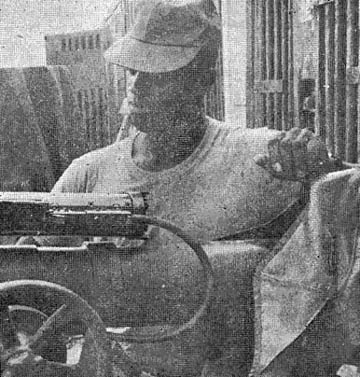 |
|
Radio And TV |
| 6:30 | News Headlines Information Please |
8:00 | Gunsmoke |
| 7:00 | Addams Family | 9:00 | Danny Kaye |
| 7:30 | News | 10:00 | The Tonight Show |
|
SATURDAY - Jan 21 |
| 1:30 | News Headlines Social Security Encyclopedia |
4:30 7:00 7:30 |
Sport Event Jim Bowie News |
| 2:00 | M-Squad | 8:00 | Jackie Gleason |
| 2:30 | Harrigan and Son | 9:00 | Hollywood Palace |
| 3:00 | Town and Country | 10:00 | Late Show |
| Swingin' Country | |||
| Beverly Hillbillies | |||
| Andy Griffith |
|
SUNDAY - Jan 22 |
| 1:30 | News Headlines | 4:30 | Sports |
| Chapel of the Air | 7:00 | 20th Century | |
| 7:30 | News | ||
| 2:00 | Back to Budapest | 8:00 | Dick Van Dyke |
| 3:00 | Movie | 9:00 | Bonanza |
| 10:00 | Ed Sullivan |
|
MONDAY - Jan 23 |
| 6:30 | News - Headlines | 8:00 | Combat |
| I've Got a Score | 9:00 | Bewitched | |
| 7:00 | The Flintstones | 9:30 | Third Man |
| 7:30 | News | 10:00 | Dean Martin |
|
TUESDAY - Jan 24 |
| 6:30 | News - Headlines | 7:30 | News |
| What's My Line | 8:00 | Rawhide | |
| 7:00 | My Favorite Martial | 9:00 | 12 O'Clock High |
| 10:00 | Ice Follies |
|
WEDNESDAY - Jan 25 |
| 6:30 | News - Headlines | 8:00 | Perry Mason |
| Information Feature | 9:00 | Roger Millies Show | |
| 7:00 | Batman (Part 1) | 9:30 | Channel 11 (Movie) |
| 7:30 | News |
|
THURSDAY - Jan 26 |
| 6:30 | News - Headlines | 8:00 | The F.B.I. |
| G.E. Bowl | 9:00 | Joey Bishop | |
| 7:00 | Batman (Part 2) | 9:30 | Have Gun Will Travel |
| 7:30 | News | 10:00 | Milton Berle |
|
Saigon 540ke |
| 0005 | Be Still and Know | 1220 | USO Show |
| 0007 | Sign Off/On | 1305 | Feature Report |
| 0015 | Night Train | 1330 | Popular Music |
| 0305 | Small World | 1405 | Country Music |
| 0405 | Bill Stewart Show | 1505 | Afternoon Break |
| 0505 | Country Corner | 1705 | Monitor |
| 0600 | Expanded News (10) | 1800 | News and Sports (30) |
| 0610 | Meditations | 1830 | Music By Candlelight |
| 0615 | Dawnbuster | 1905 | Swinging 60's |
| 0705 | Morning Meditations | 2005 | Aussie News |
| 0710 | Dawnbuster | 2010 | Jazz Concert |
| 0830 | Ira Cook | 2105 | Chris Noel |
| 0905 | Bill Stewart Show | 2200 | News and Sports (30) |
| 1005 | Destination Noon | 2230 | Night Beat |
| 1200 | News & Sports |
|
SATURDAY |
| 0005 | Be Still and Know | 1330 | Silver Platter |
| 0007 | Sign Off/On | 1355 | Point of Law |
| 0015 | Jazz Show Case | 1400 | Country Music |
| 0105 | Night Train | 1455 | News (5) |
| 0505 | Jim Pewters | 1500 | Football |
| 0600 | News (10) | 1705 | Bolero Time |
| 0610 | Meditations | 1800 | News |
| 0615 | Dawnbuster | 1839 | Candlelight Music |
| 0705 | Mediatations | 1905 | Sammy Davis Show |
| 0710 | Dawnbuster | 2005 | Grand Ole Opry |
| 0905 | Polka Party | 2105 | Aussie News |
| 1005 | Saturday Swing | 2110 | Night Beat |
| 1200 | News and Sports (30) | 2200 | News and Sports (30) |
| 1230 | Navy Hour | 2305 | Patty Show |
| 1255 | World of Money | ||
| 1305 | Feature Report |
|
SUNDAY |
| 0005 | Be Still and Know | 1305 | Panorama |
| 0007 | Sign Off/On | 1455 | News (5) |
| 0015 | Night Train | 1500 | Football |
| 0505 | Jim Ameche | 1705 | Afternoon Music |
| 0600 | News (10) | 1800 | News & Sports (30) |
| 0610 | Morning Music | 1830 | Candlelight Music |
| 0805 | Tabernacle | 1905 | Roger Carroll |
| 0830 | Protestant Hour | 2005 | Footlights, Soundtracks |
| 0905 | Message of Israel | 2105 | Aussie News |
| 0930 | Hour of the Crucified | 2115 | Night Beat |
| 1005 | Morning Music | 2200 | News & Sports (30) |
| 1200 | News and Sports (30) | 2230 | Night Beat |
| 1230 | Army Hour | 2305 | Night Life |
| 1255 | World of Money |
Page 12 TROPIC LIGHTNING NEWS January 20, 1967
A Good Storey:
Capt. Goes Down With His Ship
By Sgt. Bill Becker
Operation “Cedar Falls,” the largest ground action of the war, has caused at
least one dispute between units of the 25th Div and local Viet Cong for right of
way on the Saigon River and its tributaries.
Positioned along the river on the bank opposite the Iron Triangle the
division is finding the waterways as useful for supply and mobility as the VC
have found it in the past. But the enemy is reluctant to give up the river.
In one recent example, a 25th unit was taking advantage of a tributary and
cover of darkness to re-supply its elements. The 25th company was using a
convoy of three sampans to take munitions from its third platoon on one bank to
its 1st and 2nd platoons on the other.
“My first platoon leader and I were leading two sampans full of supplies in a
rickety old boat that could barely hold us,” said Capt. Charles C. Storey, Jr.,
company commander. “Suddenly we spotted another sampan coming our direction.
There were three VC aboard.”
Capt. Storey waited until the enemy sampan was about 50 feet away and opened
up with his 12 gauge shot gun. While the captain poured shells at the VC the
platoon leader, 1st Lt. Charles E. Glasscock tried to steer. The action was too much for the old boat - it came
apart and began sinking.
The lieutenant swam to one bank where the two supply ships picked him up.
They went down the tributary; unloaded and started back to find Capt. Storey.
“We found him near the other bank,” said Lt. Glasscock. “When he heard our
motor, he switched his flashlight on under the water so we could spot him.”
When the tide went down the next morning, the two went back up the tributary
to find evidence of the encounter. The VC boat was still there, stained with
blood, and containing web gear, two hats and three pairs of shoes.
On the bank, they found two more sets of web bear, a carbine and a Russian
rifle.
“The whole thing is almost funny when I look back on it,” Capt. Storey said,
“but at the time it was one hairy situation.”
Kids Aided – 4/31 Now New Orleans Citizens
When the men of Co A, 4th Bn, 31st Inf, 196th Lt Inf Bde, received letters
from the Jamieson children of New Orleans, they were delighted.
The children had written several letters to the company thanking them for the
job they are doing in Vietnam and telling them that America is behind them.
To show their appreciation the “Go-Go Men” sent the Jamieson kids a money
order for $100 to help decorate their Christmas tree.
The Christmas gift couldn’t have come at a better time.
The Jamiesons, a family of 10, had just moved to a larger home when two of
the eight children were hospitalized with pneumonia. Expenses from the move and
the hospital bills made a Merry Christmas seem pretty unlikely. When the “Go-Go
Gift” arrived ti was just like Santa making his visit early.
Mrs. Jamieson wrote, “Thanks to you, our Christmas will be a merry one. Our
tree was purchased with part of the money and on top our angel holds a card
saying from a “Go-Go Company”, for you see we think of you as our angels.”
The turkey and gifts were also purchased with the “Go Go gift,” and to make
the season ever merrier, the two hospitalized children returned home for
Christmas.
Mrs. Jamieson ended, “Our babies are home and well again so you know that God
has surely blessed all of us, first by giving us health but also by giving us so
very many dear friends like you men who think of us at this time.”
Mayor Victor A. Shiro of New Orleans, after learning of the gift, sent a
Certificate of Honorary Citizenship and the “Key to the City” to the men of the
company. A Certificate of Merit was also received from the Jamieson’s parish
Jefferson (County) for “outstanding service.”
45th Hospital Road Dedicated
Maj. Gary P. Wratten, commanding officer of the 45th Surgical Hospital,
arrived at the Tay Ninh base camp of the 196th Lt Inf Bde on Nov. 2nd eagerly
anticipating the opening of the hospital and the wealth of services it will
provide for the sick and wounded. Two days later the base camp was mortared,
and Maj. Wratten was fatally wounded.
In tribute to his enthusiasm and efforts, Maj. Charles M. Lyon, commander of
the Army’s first MUST (Mobile Unit Self-Contained Transportable) equipped
hospital has named the 45th Surgical’s new service road, the Gary P. Wratten
Road.
Brig. Gen. Richard T. Knowles, commanding general of the 196th, remarked at
the dedication ceremony, “This is a fitting tribute to Maj. Wratten and will
stand as a monument, an inspiration to all who work for freedom.”
General Knowles and Capt. (Chaplain) Robert Covington of San Antonio, Tex,,
unveiled the new street sign. As Maj Lyon officially dedicated the assembled
corpsmen, doctors and nurses stood at attention and a 13-piece band from the 1st
Philippine Civic Action Group played the “Star Spangled Banner.”
Maj. Wratten was graduated from the University of Buffalo Medical School in
1950. He was commissioned a first lieutenant in the Army Medical Corps the
same year he attended Brook General Hospital, Ft. Sam Houston, Tex.
He was promoted to captain while a resident in general surgery at Walter Reed
Hospital from 1959 to 1963.
Later, at Walter Reed he headed the Clinical Section, general service, and
then became chief of head and neck services. During this time he also taught at
Johns Hopkins University. Certified by the American Board of Surgeons in 1964,
he was appointed commander of the 45th Surgical Hosp. in June of 1966.
Maj. Wratten is survived by his wife, Shirley, and their four sons,
Christopher, Timothy, Leigh and Thomas and a daughter, Linda, of Silver Springs,
Md.
The dream Maj. Wratten envisioned has in itself become a shrine to his
dedicated services. Since becoming operational less than two months ago, the
MUST hospital has treated more than 300 patients.
196th Helps Delta Flood Victims
The 196th Lt Inf Bde contributed more than 3 1/2 tons of beans captured on
Operation Attleboro to the Tay Ninh Regional USAID (United States Aid to
International Development). The beans were given by the brigade to help the
recent victims of the Mekong River floods.
The hard green bean which the Vietnamese cook with sugar and make into a
soup, was sent to delta villagers, for reseeding purposes.
USAID representative Dale Pfeiffer, acted as a liaison for the Army in
transporting the beans from the “Charger” brigade.
Together with the beans, 103 metric tons of peanuts were also flown to the
villages hit by the flood.
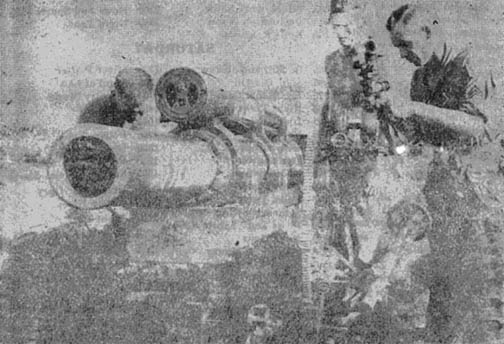 |
| ATTLEBORO - The first 105mm howitzer of the 196th Lt Inf Bde, belonging to the 3rd Bn, 82nd Arty, gets a thorough check-out by its crew. The howitzer, called “Attleboro,” was named following Operation Attleboro. (Photo by 1st Lt. Ambrosio Sarmiento) |
Thanks to:
Jim Reynolds, 125th Signal Battalion,
for sharing this issue,
Kirk Ramsey, 2nd Bn., 14th Inf. for creating this page.
This page last modified
01-16-2008
©2008 25th Infantry Division Association. All rights reserved